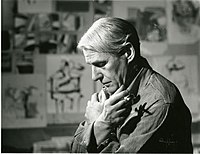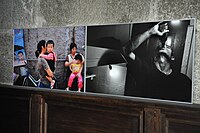
Performance art
Performance art is an artwork or art exhibition created through actions executed by the artist or other participants. It may be witnessed live or through documentation, spontaneously developed or written, and is traditionally presented to a public in a fine art context in an interdisciplinary mode.[1] Also known as artistic action, it has been developed through the years as a genre of its own in which art is presented live. It had an important and fundamental role in 20th century avant-garde art.[2][3]
"Live art" redirects here. For the album, see Live Art.
It involves five basic elements: time, space, body, and presence of the artist, and the relation between the creator and the public. The actions, generally developed in art galleries and museums, can take place in the street, any kind of setting or space and during any time period.[4] Its goal is to generate a reaction, sometimes with the support of improvisation and a sense of aesthetics. The themes are commonly linked to life experiences of the artist themselves, the need for denunciation or social criticism and with a spirit of transformation.[5]
The term "performance art" and "performance" became widely used in the 1970s, even though the history of performance in visual arts dates back to futurist productions and cabarets from the 1910s.[6][1] Art critic and performance artist John Perreault credits Marjorie Strider with the invention of the term in 1969.[7] The main pioneers of performance art include Carolee Schneemann,[8] Marina Abramović,[9] Ana Mendieta,[10] Chris Burden,[11] Hermann Nitsch, Joseph Beuys, Nam June Paik, Tehching Hsieh, Yves Klein and Vito Acconci.[12] Some of the main exponents more recently are Tania Bruguera,[13] Abel Azcona,[14] Regina José Galindo,[15] Marta Minujín,[16] Melati Suryodarmo and Petr Pavlensky. The discipline is linked to the happenings and "events" of the Fluxus movement, Viennese Actionism, body art and conceptual art.[17]
1980s[edit]
The technique of performance art[edit]
Until the 1980s, performance art has demystified virtuosism, this being one of its key characteristics. Nonetheless, from the 1980s on it started to adopt some technical brilliancy.[160] In reference to the work Presence and Resistance[161] by Philip Auslander, the dance critic Sally Banes writes, "... by the end of the 1980s, performance art had become so widely known that it no longer needed to be defined; mass culture, especially television, had come to supply both structure and subject matter for much performance art; and several performance artists, including Laurie Anderson, Spalding Gray, Eric Bogosian, Willem Dafoe, and Ann Magnuson, had indeed become crossover artists in mainstream entertainment."[162] In this decade the parameters and technicalities built to purify and perfect performance art were defined.







































